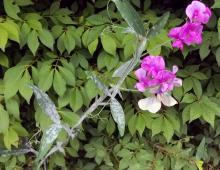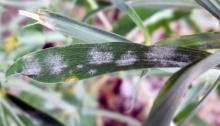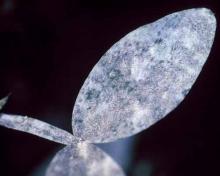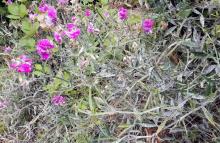Cause Erysiphe pisi var. pisi (formerly Erysiphe polygoni), has been reported from the Pacific Northwest; Erysiphe lathyricola (formerly Microsphaera diffusa) has been reported from Oregon. Erysiphe trifoliorum has also been reported from North America. These fungi are favored by conditions that produce high humidity but dry leaves. They are highly specialized pathogens that form close associations with hosts. Conditions that favor the host also favor the pathogen. Much of the fungus remains outside infected plant parts where it grows on the surface but sinks root-like structures called haustoria into plant cells to obtain nutrients. The white growth seen is composed of both mycelium and fungal spores.
Symptoms Grayish white, powdery spots develop on both sides of leaves. Some yellowing and premature defoliation may be observed. Small black fruiting bodies (chasmothecia) may be seen in the white patches later in the growing season.
Cultural control
- Space plants for good air circulation.
Chemical control Fungicides will do best when used before symptoms develop. Few materials have good eradicant activity. Use at 7- to 14-day intervals; using shorter intervals when environmental conditions favor disease development. Alternate or tank-mix products from different groups that have different modes of action. Limit the use of any one group during crop production.
- Seido at 4 to 5 fl oz/100 gal water plus an adjuvant. Group 50 fungicide. 4-hr reentry.
- Thiolux (80% sulfur) at 3 to 10 lb/A. Group M2 fungicide. 24-hr reentry. O
Reference Braun, U. and Cook, R.T.A. 2012. Taxonomic Manual of the Erysiphales (Powdery Mildews). CBS-KNAW Fungal Biodiversity Center, The Netherlands.





